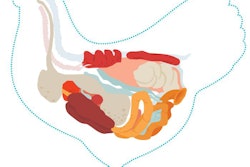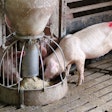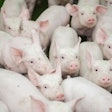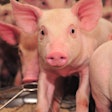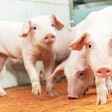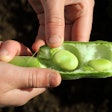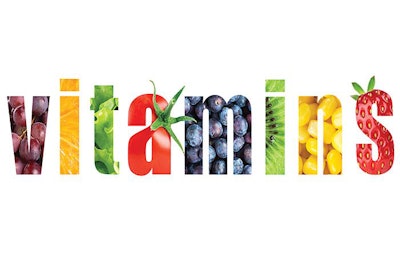
Vitamin E is a well-known vitamin in that it is included in almost all animal feeds, being a compound of so many functions. But, if we were to give it a commercial nickname, we could call it the “piglet vitamin” if only because nutritionists and veterinarians often prescribe high concentrations of it for a variety of reasons and purposes. As it happens, vitamin E is not cheap, and quality products are worth their money — after all, vitamins are considered essential nutrients. So, in order to justify the usage of vitamin E at elevated levels in piglet diets, we must first understand its many roles.
Essential vitamin
Vitamin E is a natural compound found in two forms: tocopherol and tocotrienol. Each form is encountered as alpha, beta, gamma, and delta tocopherol and tocotrienol, respectively. Of all these, d-alpha-tocopherol has the greatest biological efficacy, followed by the L-isomer. The dl form is usually taken as the standard in discussing vitamin E nutrition. In other words, the international unit (IU) of vitamin E is taken as the activity of 1 mg of dl-alpha-tocopherol acetate (Table 1). The first recognized role of vitamin E was that of being essential in reproduction functions, hence its original name of toco- (birth, in Greek) and -pherol (bring about, in Greek). Later, it was recognized as one of the two essential antioxidant elements that needed to be supplemented in animal feeds, the other being selenium.

The international unit (IU) of vitamin E is taken as the activity of 1 mg of dl-alpha-tocopherol acetate.
The primary source material for vitamin E has been the tocopherols found in leguminous seeds high in oil, mostly from soybeans. Nevertheless, such natural sources are prone to rapid oxidation. As such, modern practices call for supplemental vitamin E to be provided through a vitamin premix. This premix should contain enough vitamin E to cover completely the entire vitamin E needs of the animal for a number of reasons, such as to:
- Safeguard against unpredictable variability in supply from natural ingredients
- Compensate against potential losses during feed processing and storage
- Allow for unavoidable reactions with other nutrients, such as lipids and vitamin A
Requirements versus specifications
The minimal requirements for prevention of deficiency symptoms and adequate performance under good rearing conditions for relatively healthy animals have been established by the National Research Council (NRC, 1998 and 2012). This value for piglets (less than 10 kilograms body weight) is just 16 IU vitamin E (including all sources in the feed). However, such values should be considered with care as they are derived from experiments done in the 60s and 70s, so they are at best outdated; they do not take into account practical/commercial situations that increase vitamin E needs; and they do not consider the extra-nutritional role of vitamin E. Therefore, while research nutritionists discuss about “requirements,” field nutritionists should consider feed “specifications.”
A number of scientific bodies have undertaken the effort to provide such specifications, along with commercial entities, including vitamin E suppliers. Such are the values of British Society of Animal Science (BSAS, 2003), National Swine Nutrition Guide (NSNG, 2010) and Danish Pig Research Center (2013) that support values of 80, 60 and 140 IU vitamin E, always for piglet feeds. Of course, in commercial practice, levels up to 250 IU vitamin E are used for specific reasons such as optimum immune function — nowadays highly relevant due to lower use of antibiotics worldwide — in high-quality piglet feeds, and this should be considered as the other extreme to NRC levels. In practice, more moderate levels of around 100 IU are the norm, increased as circumstances dictate. Finally, if we were to examine a well-known commercial guideline, we could mention the levels of 100 to 150 IU as supported by the Optimum Vitamin Nutrition concept of DSM — again, not very far from the two extremes discussed here.
Considering practical levels of vitamin E
Let us start by the highest recommended feed specification for vitamin E, that of 250 IU. This is usually a level of supplementation employed in high-quality, and expensive, creep feeds and those right after weaning. The major argument behind this supra-nutritional level of vitamin E is that of enhanced immune system reaction. Indeed, some evidence exists in that high levels of vitamin E can increase blood immunoglobulin levels, leading to better disease resistance. It should also be noted that during times of acute stress (such as weaning time), the immune system is malfunctioning, whereas oxidative stress accumulates damaging free radicals. It is thus not unreasonable to consider such use of vitamin E as a safeguard against post-weaning trauma.
The more moderate levels of 100 to 150 IU are supported not only by health claims, but also from the fact that such sensitive and expensive piglet feeds abound with factors that reduce or destroy vitamin E potency. For example, a high lipid concentration is common in high-energy density piglet diets, and this is bound to generate a wave of free radicals at different stages. In fact, some older textbooks recommended a formula where each percentage point of feed lipids required supplementation of 5 extra IU of vitamin E. In addition, as mentioned, modern piglet feeds are usually rich in vitamin E, organic acids and trace minerals, all of which can interact with vitamin E, reducing the levels reaching the animal.
Picking one level of vitamin E for all piglet feeds appears to be an oversimplification as existing vitamin E “requirements” are inadequate for modern production practices.
At the other end of the spectrum are those premixes and feeds that encourage a low(er) level of vitamin E supplementation. First, this is because cost remains a valid consideration in this industry. Second, not all piglet feeds are high-end, meaning they may not contain compounds with a negative action against vitamin E. Third, not all nutritionists are convinced that we should not take into account natural ingredients in terms of vitamin supplementations. Fourth, some feeds are not for commercial use, and they do not suffer from long(er) storage and competition, being in-house feeds that are consumed within days from manufacturing.
In balance
Picking one level of vitamin E for all piglet feeds appears to be an oversimplification as existing vitamin E “requirements” are inadequate for modern production practices, if we want to account for supra-nutritional needs such as immunity and oxidative stress. In addition, not all feeds are inert toward vitamin E, and piglet feeds remain the most aggressive against this antioxidant that readily becomes oxidized when it comes in contact with oxidative agents in feeds, such as those abounding in modern piglet feeds. In balance, one needs to consider carefully what levels of vitamin E should be used in each specific feed to maximize the health and performance of animals as well as return on the investment to farmers, if only because vitamin E remains not a cheap but definitely indispensable nutrient.
Read more: How animal feed oxidation affects livestock productivity

A number of scientific bodies have undertaken the effort to provide vitamin E specifications.


